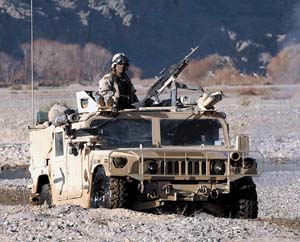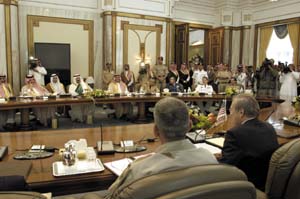Preparation Built Successes in Afghanistan, Iraq
 |
Members of the 3rd Special Forces Group drive through a river to the Daychopan region of Afghanistan. Gen. Tommy Franks, USA (Ret.), commander of the U.S. Central Command (CENTCOM) during the Afghanistan War, relates that the command began planning for operations in that country shortly after the September 11, 2001, terrorist attacks on the United States. |
The groundwork for the rapid achievements of operations Enduring Freedom and Iraqi Freedom was laid in the years before those two wars even loomed on the U.S. national horizon, according to the general who led coalition forces in both victories. Long-term efforts in peacetime placed U.S. forces in a position to ramp up quickly for wars that achieved their main goals quickly.
Gen. Tommy Franks, USA (Ret.), commanded the U.S. Central Command (CENTCOM) in a period of time that progressed from relative calm to warfare punctuated by terrorist attacks and regional political and military crises. He states that decisions made in the 1990s and activities underway since the end of the first Gulf war led to the command’s success in Afghanistan and Iraq.
Since 1992, CENTCOM not only had been training to warfight, it also had been conducting operations Southern Watch and Northern Watch in the no-fly zones in northern and southern Iraq. This provided the command with a blend of operational capability based on experience and the joint force training that CENTCOM was doing in exercises such as bright star in Egypt. All of these came together as a precursor to what the command was asked to do in both Afghanistan and Iraq, Gen. Franks says.
The general relates that, when he took command of CENTCOM in the summer of 2000, it was a peacetime command. Following in the footsteps of his predecessor, Gen. Anthony Zinni, USMC (Ret.), he and his staff worked hard at establishing relationships among the region’s 25 countries. Gen. Franks notes that the same time frame featured a nuclear standoff between India and Pakistan, two of the region’s key nations. Both countries now are important U.S. allies in the war on terrorism.
That fall, the USS Cole was struck by al Qaida terrorists in Aden harbor in Yemen. “The United States found itself in the position that, even if it had not declared war on anyone, its people in the region had war declared on them,” he observes.
CENTCOM recognized the importance of command and control (C2), particularly the ability to communicate across vast distances, the general continues. The command began to generate a C2 capability that it had never had before. When the Bush administration took office in January 2001, CENTCOM had to build relationships with the new civilian leadership in Washington. That action was concurrent with its relationship-building efforts with the foreign leaders in CENTCOM’s area of operation, as well as inside the command itself.
All of those efforts represented a metamorphosis from a peacetime command to one operating under an elevated level of hostility after the Cole attack, followed by the onset of a new administration in Washington and, ultimately, the September 11, 2001, terrorist attacks in the United States. Recognizing that the source of those attacks was in Afghanistan, CENTCOM began to set conditions to take the United States to war, Gen. Franks relates.
Several actions during this period of time proved vital to the wars in Afghanistan and Iraq, the general allows. The building of relationships with national leaders in the region proved to be key. Gen. Franks cites efforts with Egypt’s Hosni Mubarak, Jordan’s King Abdallah, Saudi Arabia’s Crown Prince Abdallah, Oman’s Sultan Qaboos and Yemen’s President Ali-Abdallah Salih, to name a few. The establishment of relationships with these and other leaders allowed the command to set conditions for CENTCOM to secure basing access, staging and overflight privileges necessary for the launch of military operations in Afghanistan.
 |
U.S. Secretary of Defense Donald H. Rumsfeld and Gen. Franks meet with Saudi Arabian officials during the Iraq War. Gen. Franks credits CENTCOM’s efforts to build relationships among the region’s nations during the months before the Afghanistan and Iraq wars with helping ensure the success of those two operations. |
The major difference between the wars in Afghanistan and Iraq was the setting, Gen. Franks states. Afghanistan is a landlocked country, but Iraq offers access from the sea as well as from neighboring nations with U.S. bases. Access basing and staging were different with each, he notes. The enemy formations and capabilities also were vastly different with each adversary.
What was not different was the level of expertise available in CENTCOM for each nation, the general offers. The command searched the United States for academic experts in each nation. It brought in Afghans to educate officials about their country, and it tapped Russians for their expertise in operations against the Mujaheddin. For planning the Iraq War, the command brought in Iraqis, he relates. All of this expertise meant that the command was well armed with information about its adversaries and the theater of operations.
The result was an operation that largely went according to plan in Afghanistan, Gen. Franks declares. “There really were no surprises. The things that we thought would be difficult in Afghanistan were difficult.
“There was a tremendous learning experience for all of us in Afghanistan because we had never used Special Operations forces at the level and in the density that they were used in that country,” he adds.
However, Iraq was a different story. Gen. Franks allows that the command was surprised by the tactics of the Fedayeen Saddam, the old regime’s national guerilla force. “The levels to which they had penetrated Iraqi society and the ruthlessness of those forces when it came to dealing not with us but with the Iraqi population were where we found the greatest surprises,” he says.
In both operations the command confirmed many theories. These included the efficacy of precision weapons, the value of realistic training and the importance of flexible and adaptable formations. Gen. Franks relates that in Afghanistan the command largely was still deconflicting operations between the services. From that war, CENTCOM learned enough to conduct truly joint operations.
“These may have been the first true joint operations that the country has conducted,” he suggests. “This [true jointness] was where one service actually relies on the performance of another service.”
Pulling together these successes requires a commander to tap all of his skills in leadership. Gen. Franks reflects that these skills came in part from recognition that life is a continuing lesson to be learned.
In terms of leadership style and ability, people are an aggregate of their experiences, he observes. All of his life’s experiences—from growing up in the Midwest and the Southwest, through school days and through his initial days in the service beginning as an enlisted man—contributed thousands of pieces that built the general’s leadership views, he relates. These views apply whether an individual commands a small unit in peacetime or an entire army in wartime.
Gen. Franks emphasizes the difference between management and leadership. “Leaders have to get the job done, but they also have to make their people like it,” he says. “There is more to it than just some mechanical form.
“I can’t think of a single occasion where a commander ever has managed people up a hill under fire,” Gen. Franks warrants.
This involves the interaction between people, he adds. “None of us are smart enough to get a few hundred thousand people to the right place at the right time to do the work that needs to be done. So, the way we compensate for our own inadequacies is by surrounding ourselves with people who are good at doing their jobs—whether they are logisticians or communicators or planners or operators.
“In the case of Central Command, we were blessed by having just a heck of a good team.”
The young warfighters of today differ from those of Gen. Franks’ Army when he enlisted as a private in 1965, he says. The level of motivation in that draft Army was different from today’s. So was the level of appreciation of the complexities of war.
“The breadth of understanding—not only of the technical things to be done by soldiers, but also the politics and the context that surrounded what was being done—was different,” he recalls.
“What we find now that causes us to say that we have the best armed forces the world has ever seen is a combination of high-technology capability and the intellectual acuity and level of maturity—as well as the level of motivation—of the young people who joined up,” he declares. “These young people simply are better troopers than we had when I was one of them at a very early age in a land far away at a time long ago.”
This is a reflection on training as well as on how today’s society views the military, the general observes. People are likely to have a sign in their front yard proclaiming their support for the troops, whereas 38 years ago that was not always the case.




Comments